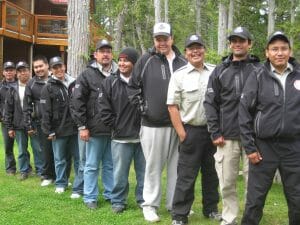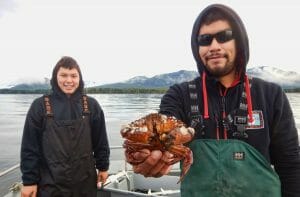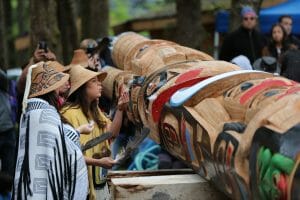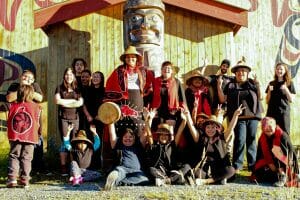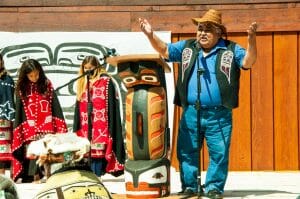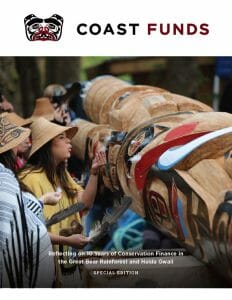Estimated Reading time

5 Mins
New Report Announces First Nations create more than 1000 permanent jobs, 100 businesses using conservation finance
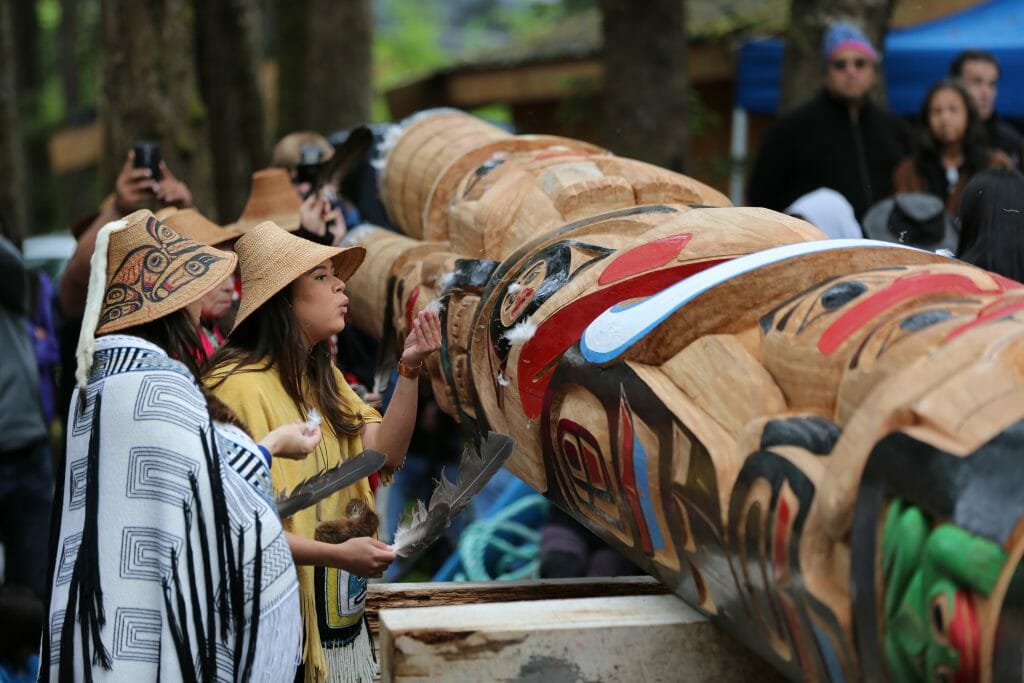
GREAT BEAR RAINFOREST, BRITISH COLUMBIA—Over the last decade, First Nations in the Great Bear Rainforest and Haida Gwaii have created a new conservation economy that links a healthy environment with the prosperity and well-being of their communities, according to a report released today by Coast Funds.
Coast Funds—an Indigenous-led conservation finance organization created through the 2006 Great Bear Rainforest agreements—announced today the results of a decade of First Nations’ investments in stewardship and sustainable development. Results include:
- More than 1000 permanent jobs have been created.
- 100 businesses have been expanded or developed.
- 14 regional monitoring and Guardian Watchmen programs, operating across an average area of 5 million hectares annually, have been created, expanded, and sustained.
“First Nations investments in stewardship and sustainable development are having major impacts in communities across the coast.” says former Coast Funds’ board chair Huux Percy Crosby, of the Haida Nation. “They are creating a new conservation economy that protects this globally significant ecosystem for generations to come—a benefit that stretches far beyond the region.”
First Nations work closely with Coast Funds to measure the contribution their investments make to strengthening environmental conservation, economic prosperity, social empowerment, and cultural vitality. Funding approved for 353 projects between 2008 and 2018 has resulted in more than $286 million in new investment attracted to the region.
“First Nations are building on a long tradition of stewarding their territories for the benefit of current and future generations,” says Brodie Guy, executive director of Coast Funds. “The benefits are substantial, and together we are demonstrating that conservation finance led by Indigenous people is the key to protecting the world’s most precious ecosystems, such as the Great Bear Rainforest and Haida Gwaii.”
First Nations-led stewardship projects cover a wide range of efforts, from 222 species research and habitat restoration initiatives, to 71 projects involving access to traditional foods, and 50 projects protecting cultural assets. Economic development investments have supported ecotourism projects, the sustainable aquaculture businesses, and the start-up of First Nations-run economic development corporations.
“Over the last 10 years First Nations in the Great Bear Rainforest and Haida Gwaii have created a road-map for how we can sustain the most ecologically significant places on the planet while enhancing the well-being of the people who have lived in those places for thousands of years,” says Crosby. “This model can and must be replicated across the globe.”
Coast Funds announced its findings from 10 years of conservation finance in a publication released June 6, 2019 To learn more, visit: https://coastfunds.ca/wp-content/uploads/2019/06/Talking-Stick-10-Years-of-Conservation-Finance-Spring-2019.pdf
—30—
Contact
Brodie Guy, Executive Director, Coast Funds
brodie@coastfunds.ca
Additional Quotes:
Coastal First Nations (Great Bear Initiative)
“Coast Funds is uniquely positioned to support our communities in building a healthy economy. Their work allows our communities to take the lead on decisions that impact us by providing financing that empowers us to set priorities, as well as to plan, develop and implement projects that are creating a sustainable coastal economy. These initiatives have a significant impact on our communities. Not just through employing people but also by creating healthier communities and building our local economies.”
-K̓áwáziɫ President Marilyn Slett, Coastal First Nations – Great Bear Initiative
Na̲nwak̲olas Council
“We are so pleased to see the numerous jobs and businesses that have been created as a result of First Nations investments with Coast Funds. Whether its training guardians to protect our lands and resources or employing our people in sustainable opportunities, it all contributes to our human well-being which was the intent when we started down this path 10 years ago.”
-President Dallas Smith, Na̲nwak̲olas Council
Spirit Bear Lodge – Kitasoo/Xai’xais (LINK)
“There’s a lot of transferable skills in ecotourism. It’s not just about viewing bears. You learn communication skills, you learn how to work with wildlife, there’s the science work that we do. It’s a lot broader and this means a lot for the community.”
-Chief Councillor Douglas Neasloss, Kitasoo/Xai’xais Nation
K̓awat̕si Economic Development Corporation – Gwa’sala-’Nakwaxda’xw Nations (LINK)
“I really believe it provides a lot of drive, especially in our young people. They’re looking beyond the current horizons and that is exciting for all of us.”
-Chief Paddy Walkus, Gwa’sala-’Nakwaxda’xw Nations
About Coast Funds
Coast Funds is a globally recognized model of Indigenous-led, permanent conservation finance that invests to strengthen the well-being of First Nations and the ecological integrity of the Great Bear Rainforest and Haida Gwaii regions of British Columbia, Canada. Founded with $118 million in 2007, and approving funding for its first project in 2008, Coast Funds is a partnership of private foundations and government. As of May 21, 2019, Coast Funds has approved $84.7 million towards 370 conservation and sustainable economic development projects. www.coastfunds.ca
About the Great Bear Rainforest
Located on Canada’s Pacific Coast, the Great Bear Rainforest and Haida Gwaii is one of the largest remaining temperate rainforests left on Earth. For thousands of years, First Nations have carefully stewarded the abundance of natural resources in the sea and on the land by relying on their knowledge of seasonal cycles to harvest a wide variety of resources without harming or depleting them. Today, First Nations are developing sustainable business opportunities while continuing to steward the region’s resources and protect the integrity of coastal ecosystems. Legally established through land-use agreements between First Nations and the Province of British Columbia in 2006, this globally unique area covers 6.4 million hectares and has been home to First Nations communities since time immemorial. www.coastfunds.ca/great-bear-rainforest/
Media Assets
